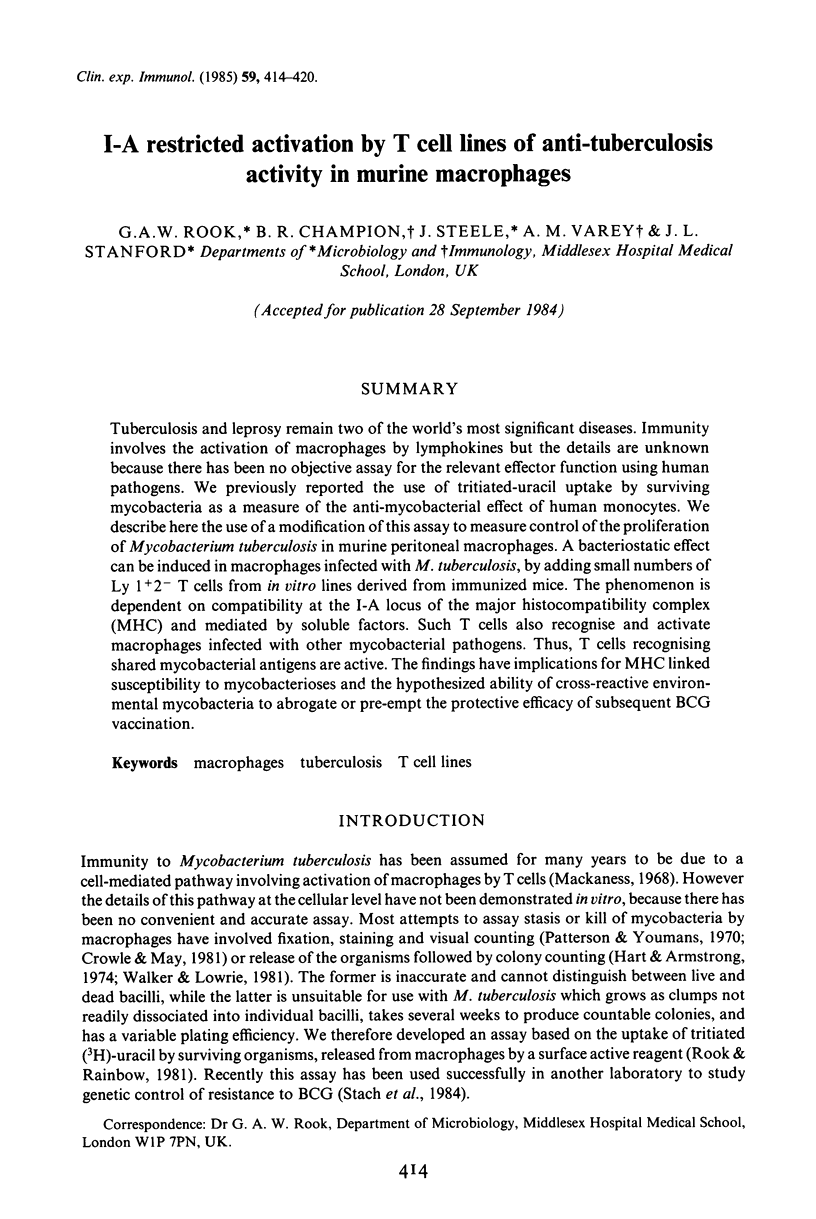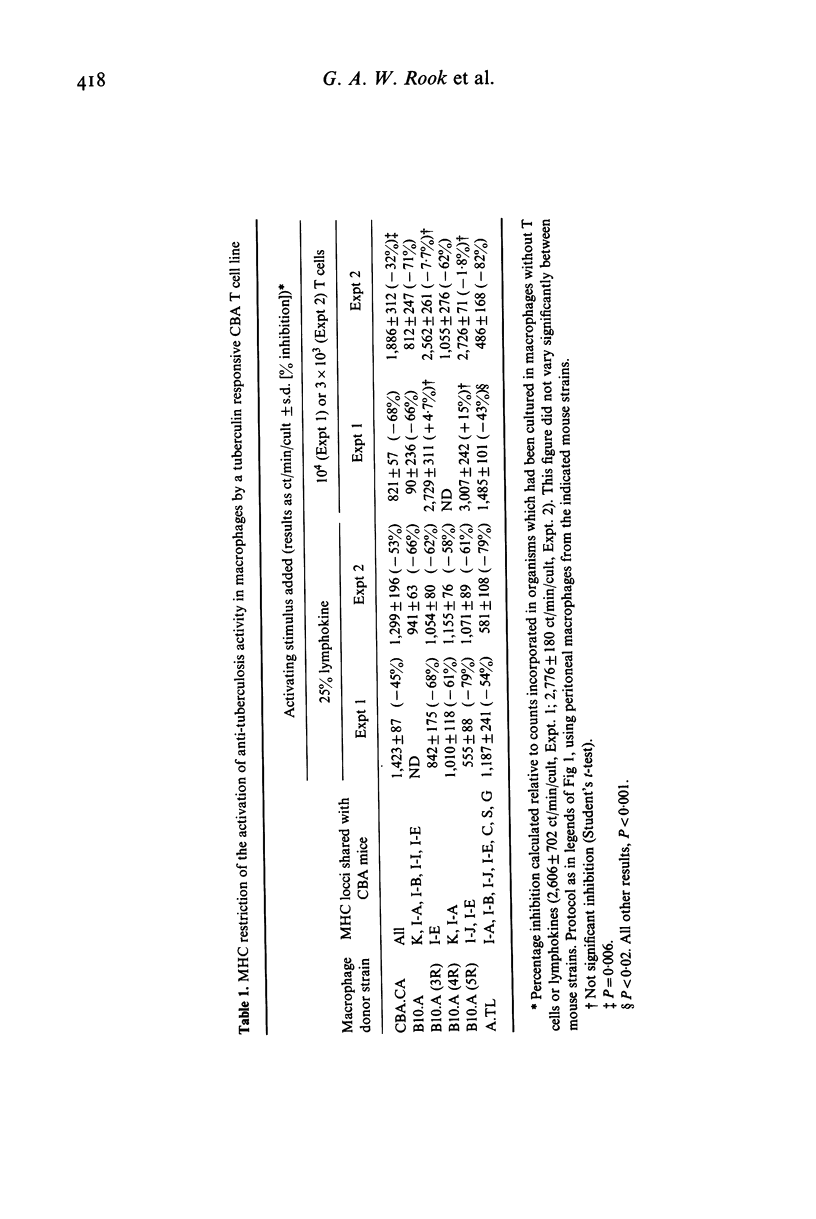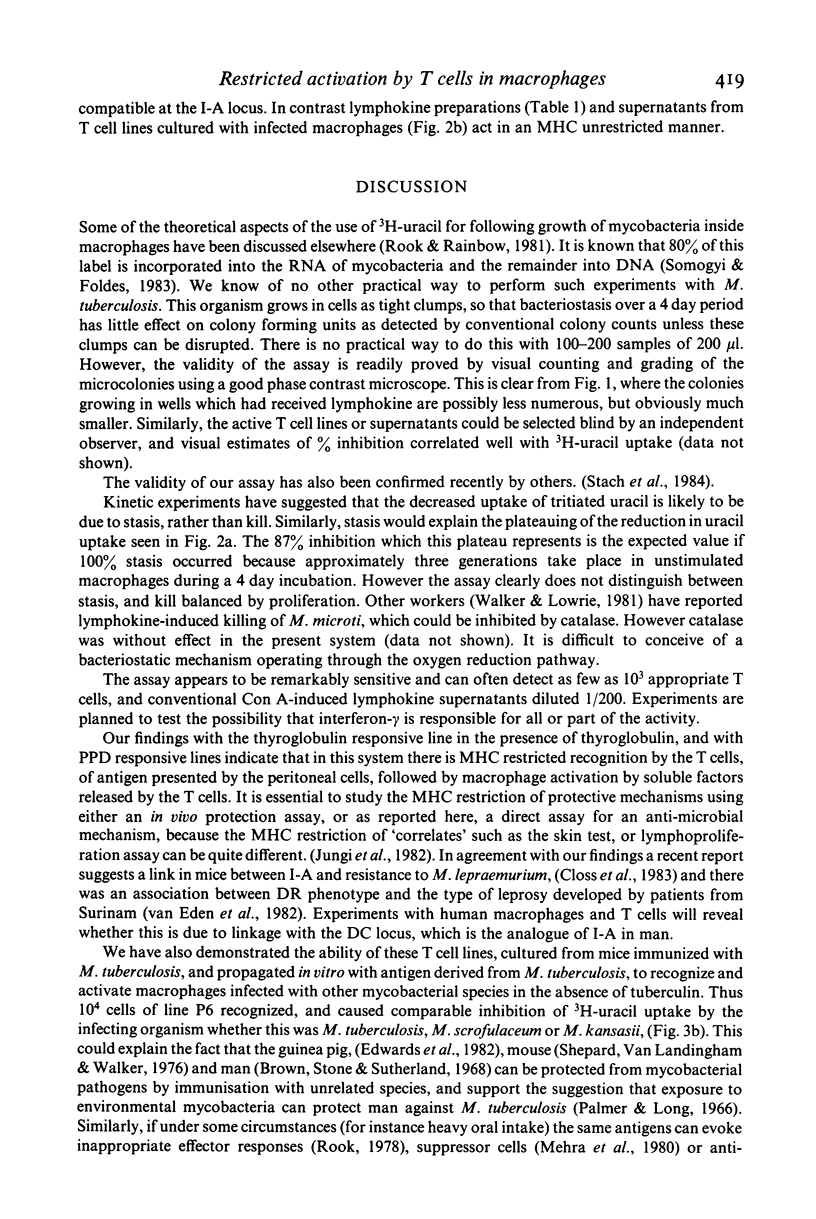Abstract
Tuberculosis and leprosy remain two of the world's most significant diseases. Immunity involves the activation of macrophages by lymphokines but the details are unknown because there has been no objective assay for the relevant effector function using human pathogens. We previously reported the use of tritiated-uracil uptake by surviving mycobacteria as a measure of the anti-mycobacterial effect of human monocytes. We describe here the use of a modification of this assay to measure control of the proliferation of Mycobacterium tuberculosis in murine peritoneal macrophages. A bacteriostatic effect can be induced in macrophages infected with M. tuberculosis, by adding small numbers of Ly 1 +2- T cells from in vitro lines derived from immunized mice. The phenomenon is dependent on compatibility at the I-A locus of the major histocompatibility complex (MHC) and mediated by soluble factors. Such T cells also recognise and activate macrophages infected with other mycobacterial pathogens. Thus, T cells recognising shared mycobacterial antigens are active. The findings have implications for MHC linked susceptibility to mycobacterioses and the hypothesized ability of cross-reactive environmental mycobacteria to abrogate or pre-empt the protective efficacy of subsequent BCG vaccination.
Full text
PDF






Images in this article
Selected References
These references are in PubMed. This may not be the complete list of references from this article.
- Brown J. A., Stone M. M., Sutherland I. B.C.G. vaccination of children against leprosy in Uganda: results at end of second follow-up. Br Med J. 1968 Jan 6;1(5583):24–27. doi: 10.1136/bmj.1.5583.24. [DOI] [PMC free article] [PubMed] [Google Scholar]
- Closs O., Løvik M., Wigzell H., Taylor B. A. H-2-linked gene(s) influence the granulomatous reaction to viable Mycobacterium lepraemurium in the mouse. Scand J Immunol. 1983 Jul;18(1):59–63. doi: 10.1111/j.1365-3083.1983.tb00836.x. [DOI] [PubMed] [Google Scholar]
- Colizzi V., Giuntini M., Garzelli C., Campa M., Falcone G. Auto-anti-idiotypic antibodies inhibit T-cell-mediated hypersensitivity in BCG-infected mice. Cell Immunol. 1983 Aug;80(1):205–210. doi: 10.1016/0008-8749(83)90107-7. [DOI] [PubMed] [Google Scholar]
- Crowle A. J., May M. Preliminary demonstration of human tuberculoimmunity in vitro. Infect Immun. 1981 Jan;31(1):453–464. doi: 10.1128/iai.31.1.453-464.1981. [DOI] [PMC free article] [PubMed] [Google Scholar]
- Edwards M. L., Goodrich J. M., Muller D., Pollack A., Ziegler J. E., Smith D. W. Infection with Mycobacterium avium-intracellulare and the protective effects of Bacille Calmette-Guérin. J Infect Dis. 1982 May;145(5):733–741. doi: 10.1093/infdis/145.2.733. [DOI] [PubMed] [Google Scholar]
- Fok J. S., Ho R. S., Arora P. K., Harding G. E., Smith D. W. Host-parasite relationships in experimental airborne tuberculosis. V. Lack of hematogenous dissemination of Mycobacterium tuberculosis to the lungs in animals vaccinated with Bacille Calmette-Guérin. J Infect Dis. 1976 Feb;133(2):137–144. doi: 10.1093/infdis/133.2.137. [DOI] [PubMed] [Google Scholar]
- Hart P. D., Armstrong J. A. Strain virulence and the lysosomal response in macrophages infected with Mycobacterium tuberculosis. Infect Immun. 1974 Oct;10(4):742–746. doi: 10.1128/iai.10.4.742-746.1974. [DOI] [PMC free article] [PubMed] [Google Scholar]
- Jungi T. W., Gill T. J., 3rd, Kunz H. W., Jungi R. Genetic control of cell-mediated immunity in the rat. III. T cells restricted by the RT1.A locus recognize viable Listeria but not isolated bacterial antigens. J Immunogenet. 1982 Dec;9(6):445–456. doi: 10.1111/j.1744-313x.1982.tb01006.x. [DOI] [PubMed] [Google Scholar]
- Mackaness G. B. The immunology of antituberculous immunity. Am Rev Respir Dis. 1968 Mar;97(3):337–344. doi: 10.1164/arrd.1968.97.3.337. [DOI] [PubMed] [Google Scholar]
- Orme I. M., Collins F. M. Protection against Mycobacterium tuberculosis infection by adoptive immunotherapy. Requirement for T cell-deficient recipients. J Exp Med. 1983 Jul 1;158(1):74–83. doi: 10.1084/jem.158.1.74. [DOI] [PMC free article] [PubMed] [Google Scholar]
- Palmer C. E., Long M. W. Effects of infection with atypical mycobacteria on BCG vaccination and tuberculosis. Am Rev Respir Dis. 1966 Oct;94(4):553–568. doi: 10.1164/arrd.1966.94.4.553. [DOI] [PubMed] [Google Scholar]
- Patterson R. J., Youmans G. P. Demonstration in tissue culture of lymphocyte-mediated immunity to tuberculosis. Infect Immun. 1970 Jun;1(6):600–603. doi: 10.1128/iai.1.6.600-603.1970. [DOI] [PMC free article] [PubMed] [Google Scholar]
- Rook G. A. Three forms of delayed skin-test response evoked by mycobacteria. Nature. 1978 Jan 5;271(5640):64–65. doi: 10.1038/271064a0. [DOI] [PubMed] [Google Scholar]
- Shepard C. C., Van Landingham R., Walker L. L. Immunity to Mycobacterium leprae infections in mice stimulated by M. leprae, BCG, and graft-versus-host reactions. Infect Immun. 1976 Oct;14(4):919–928. doi: 10.1128/iai.14.4.919-928.1976. [DOI] [PMC free article] [PubMed] [Google Scholar]
- Somogyi P. A., Földes I. Incorporation of thymine, thymidine, adenine and uracil into nucleic acids of Mycobacterium phlei and its phage. Ann Microbiol (Paris) 1983 Jan-Feb;134A(1):19–28. doi: 10.1016/0769-2609(83)90100-x. [DOI] [PubMed] [Google Scholar]
- Stach J. L., Gros P., Forget A., Skamene E. Phenotypic expression of genetically-controlled natural resistance to Mycobacterium bovis (BCG). J Immunol. 1984 Feb;132(2):888–892. [PubMed] [Google Scholar]
- Takeya K., Nomoto K., Muraoka S., Shimotori S., Taniguchi T., Miyake T. Growth of two strains of Mycobacterium bovis (BCG) in athymic mice. J Gen Microbiol. 1977 Jun;100(2):403–405. doi: 10.1099/00221287-100-2-403. [DOI] [PubMed] [Google Scholar]
- Walker L., Lowrie D. B. Killing of Mycobacterium microti by immunologically activated macrophages. Nature. 1981 Sep 3;293(5827):69–71. doi: 10.1038/293069a0. [DOI] [PubMed] [Google Scholar]
- van Eden W., de Vries R. R., D'Amaro J., Schreuder I., Leiker D. L., van Rood J. J. HLA-DR-associated genetic control of the type of leprosy in a population from surinam. Hum Immunol. 1982 Jul;4(4):343–350. doi: 10.1016/0198-8859(82)90007-6. [DOI] [PubMed] [Google Scholar]



